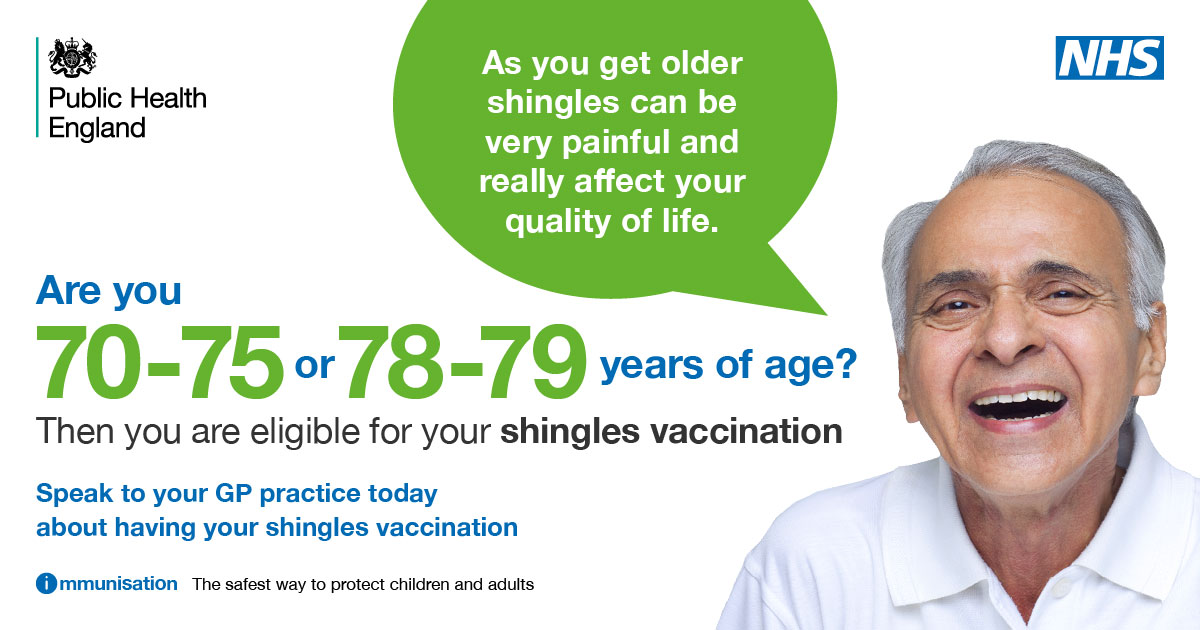
This week is European Immunisation Week (EIW) – a week to celebrate the value of vaccination, an intervention which saves millions of lives across the globe every year.
We all know that newborn babies get offered a routine schedule of immunisations to protect against nasty diseases. Most of these, including diphtheria, polio and tetanus, are luckily now rare in the UK due to the success of our immunisation programmes.
But vaccines are not just for babies. As we age and go through different life stages and become eligible for different vaccines based on how vulnerable we are to certain illnesses – including shingles.
Who is at risk of shingles?
Shingles - medically known as Herpes Zoster - develops when the dormant chickenpox virus becomes re-activated in the body. It is not ‘caught’ from other people with chickenpox or shingles.
Most people in the UK have caught chickenpox at some point in their lives, usually as children, although some people may not develop symptoms and so are unaware that they've even had it. Anyone who has had chickenpox in the past is still at risk of shingles.
Shingles can strike when people’s immune systems are particularly vulnerable, for example after having flu or going through an element of trauma.
The risk and severity of shingles also increase as you get older and your immunity wanes. Older adults are more at risk of shingles-related complications, which commonly include long term nerve pain.

Shingles can be debilitating
Many people don’t realise how serious shingles can be. It can cause severe pain for individuals, have debilitating effects for months, and in rare cases it can kill – about 50 deaths are caused by shingles every year. Some people never fully recover from the effects of shingles and are left with ongoing nerve pain (post-herpetic neuralgia).
Sometimes, people with shingles cannot bear to have anything touching their skin including clothes or water, as it’s too painful. Considering this, you can imagine how drastically it can impact someone’s life.
See images of what a shingles rash can look like here.
The shingles vaccine
The shingles vaccine was first rolled out in England in 2013. Unlike many other vaccines, the shingles vaccine only provides protection to those who receive it and it does not provide any indirect protection to other people through herd immunity. The only way to stop as many people as possible from getting it is to ensure all eligible people are vaccinated.
It’s shown to be highly effective at preventing shingles and long term chronic pain which is a common and debilitating complication. Current studies suggest that the vaccine reduces a person’s risk of getting shingles by 62% and Post-herpetic Neuralgia (PHN) by 88%. There have been approximately 17,000 fewer shingles cases amongst the 5.5 million individuals targeted for vaccination in the first three years of the programme.
Why are we seeing low uptake?
The shingles vaccine is a live vaccine (containing the weakened strain of the virus), which means it should not be given to anyone who has a condition that weakens the immune system (such as cancer or people on immunosuppressive drugs).
Who can be vaccinated?
In England, patients are eligible for the shingles vaccine as soon as they turn 70 or 78 years of age. Also anyone who was eligible in previous years but who has not yet had the vaccine remains eligible until they turn 80 (this includes anyone in their 70s who was born on or after 2 September 1942, and anyone who is 79 years old).
GP surgeries can arrange an appointment for people to receive the vaccine.
If you are unsure about eligibility try using the shingles eligibility calculator or see the shingles eligibility poster.
If you know someone who could be eligible for the vaccine, why not remind them about the fact that they can request it from their GP at any time. It might just save them from months of pain in the future, or even save their life.
